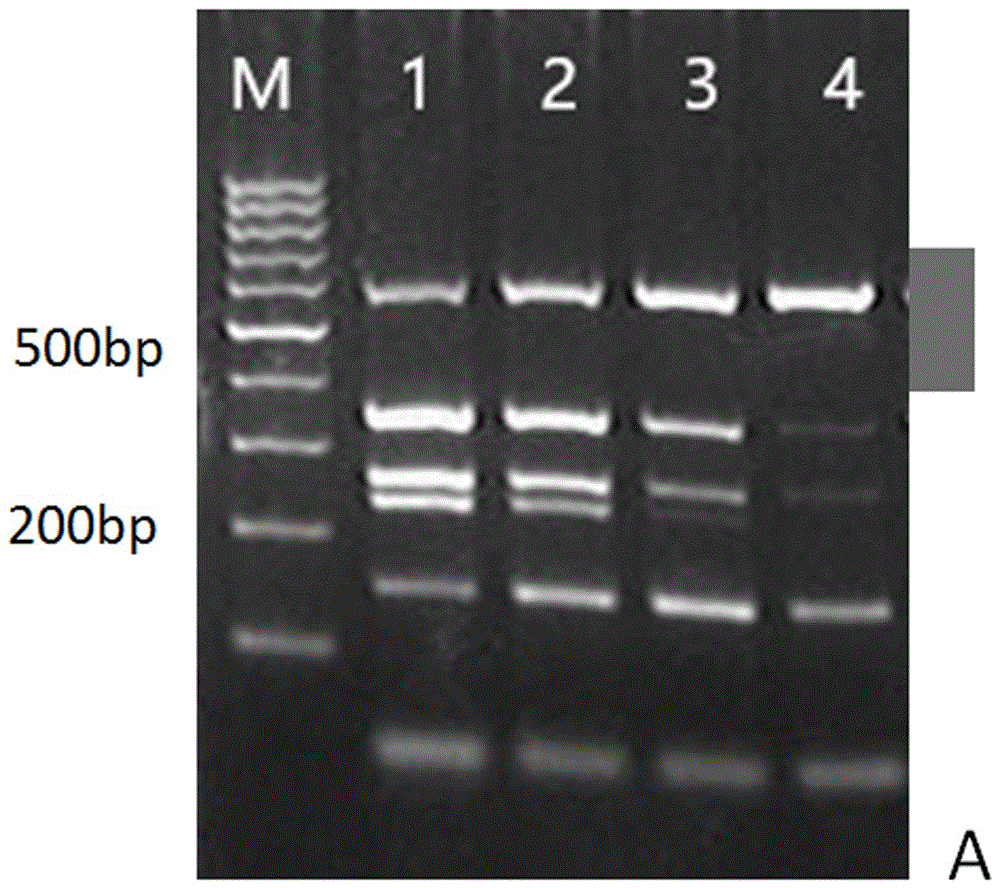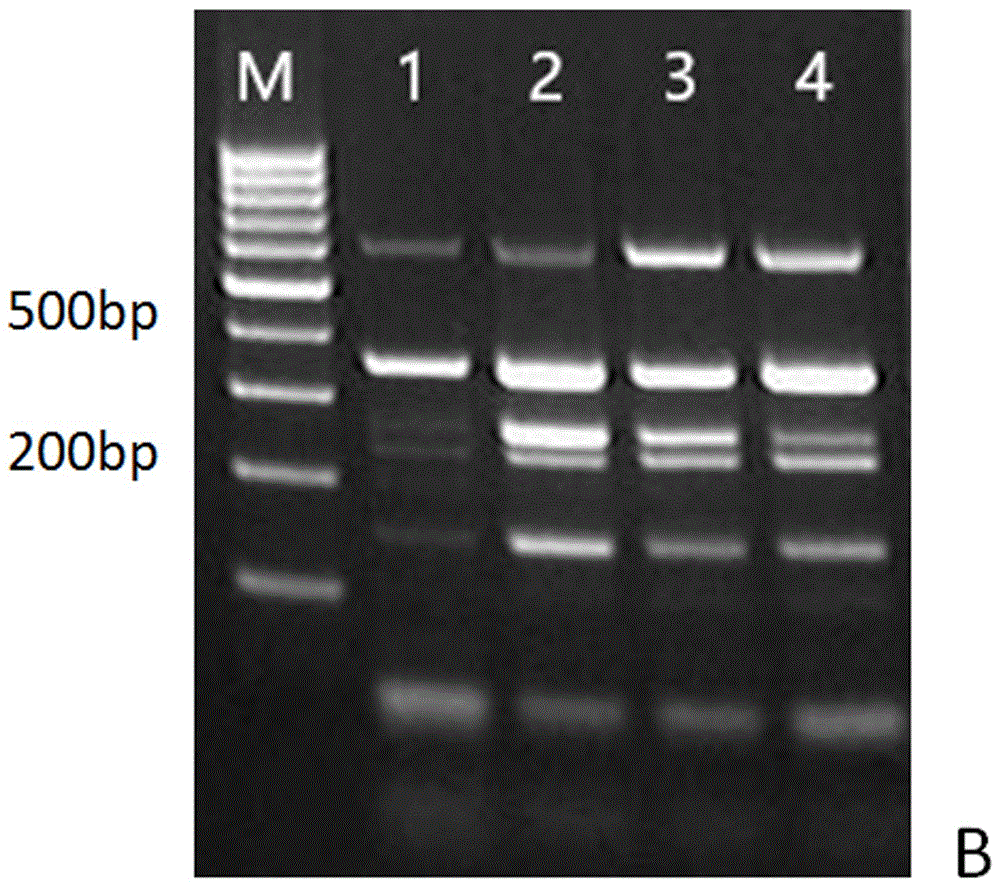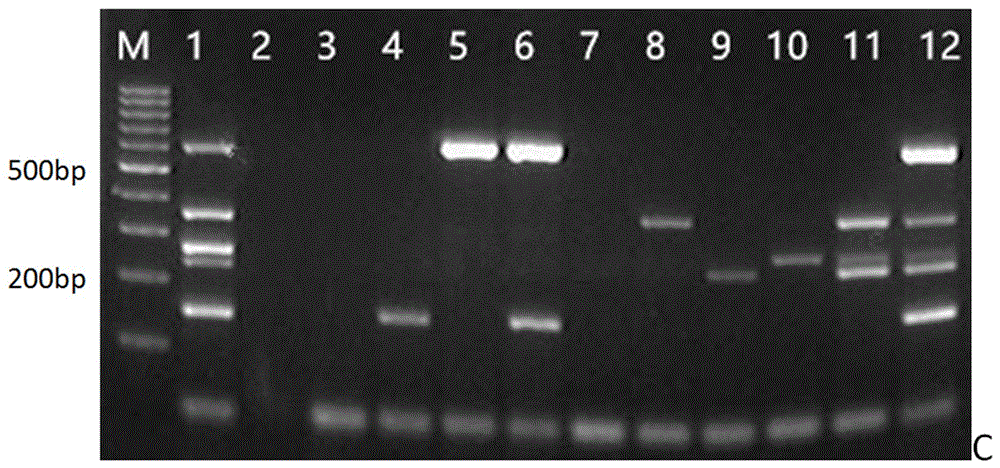Quintuple PCR (polymerase chain reaction) detection method capable of detecting multiple pathogens simultaneously
A detection method and technology for killing Pasteurella multocida, applied in the field of PCR detection, can solve the problems of cumbersome process, time-consuming, low detection rate, etc., and achieve the effects of improving detection efficiency, shortening detection time, and reducing requirements
- Summary
- Abstract
- Description
- Claims
- Application Information
AI Technical Summary
Problems solved by technology
Method used
Image
Examples
Embodiment 1
[0024] Example 1 Optimization of the annealing temperature for the five-fold PCR system of Staphylococcus aureus, Pseudomonas aeruginosa, Pasteurella multocida, Bordetella bronchiseptica and Mycoplasma pneumoniae
[0025] (1) Sample pretreatment
[0026] Standard Staphylococcus aureus, Pseudomonas aeruginosa, Pasteurella multocida, Bordetella bronchiseptica and Mycoplasma pneumoniae were respectively cultured in the corresponding medium or culture solution, among which Staphylococcus aureus and Pseudomonas aeruginosa were cultured for 24 hours , Pasteurella multocida and Bordetella bronchiseptica were cultured for 36 hours, and Mycoplasma pneumoniae were cultured for 7 days, and the corresponding DNA samples were extracted from the bacterial liquid or colonies.
[0027] (2) Bacterial DNA extraction
[0028] The present invention adopts bacterial genomic DNA extraction kit to extract DNA, and the steps are as follows:
[0029] ① Dissolve the above-mentioned 5 kinds of pathoge...
Embodiment 2
[0041] Example 2 Detection of five-fold PCR artificial samples of Staphylococcus aureus, Pseudomonas aeruginosa, Pasteurella multocida, Bordetella bronchiseptica and Mycoplasma pneumoniae
[0042] (1) Sample pretreatment
[0043] Sample feces and tracheal secretions from the animal to be tested.
[0044] (2) Bacterial DNA extraction
[0045] Same as Example 1
[0046] (3) Establishment of multiplex PCR reaction system
[0047] PCR reaction system is 50 μl, Mix 25 μl, primer 7 μl, upstream and downstream primers for Staphylococcus aureus, Pseudomonas aeruginosa, Pasteurella multocida, Bordetella bronchiseptica and Mycoplasma pneumoniae are 1 μl, 1 μl, 0.5 μl, 0.5 μl respectively , 0.5 μl, DNA was positive control 5 μl, negative control 0 μl, sample feces and tracheal secretions were 2 μl each, and the remaining sterile water was added to 50 μl. Reaction conditions: pre-denaturation at 94°C for 5 minutes; cycle at 94°C for 30s, 60°C for 30s, and 72°C for 30s, a total of 30 c...
Embodiment 3
[0050] Example 3 Detection of five-fold PCR samples of Staphylococcus aureus, Pseudomonas aeruginosa, Pasteurella multocida, Bordetella bronchiseptica and Mycoplasma pneumoniae
[0051] (1) Sample pretreatment
[0052] Sample feces and tracheal secretions from the animal to be tested.
[0053] (2) Bacterial DNA extraction
[0054] Same as Example 1
[0055] (3) Establishment of multiplex PCR reaction system
[0056] PCR reaction system is 50 μl, Mix 25 μl, primer 7 μl, upstream and downstream primers for Staphylococcus aureus, Pseudomonas aeruginosa, Pasteurella multocida, Bordetella bronchiseptica and Mycoplasma pneumoniae are 1 μl, 1 μl, 0.5 μl, 0.5 μl respectively , 0.5 μl, DNA was positive control 5 μl, negative control 0 μl, sample feces and tracheal secretions were 2 μl each, and the remaining sterile water was added to 50 μl. Reaction conditions: pre-denaturation at 94°C for 5 minutes; cycle at 94°C for 30s, 60°C for 30s, and 72°C for 30s, a total of 30 cycles; fina...
PUM
 Login to View More
Login to View More Abstract
Description
Claims
Application Information
 Login to View More
Login to View More - R&D
- Intellectual Property
- Life Sciences
- Materials
- Tech Scout
- Unparalleled Data Quality
- Higher Quality Content
- 60% Fewer Hallucinations
Browse by: Latest US Patents, China's latest patents, Technical Efficacy Thesaurus, Application Domain, Technology Topic, Popular Technical Reports.
© 2025 PatSnap. All rights reserved.Legal|Privacy policy|Modern Slavery Act Transparency Statement|Sitemap|About US| Contact US: help@patsnap.com



